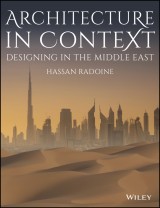Details

Architecture in Context
Designing in the Middle East1. Aufl.
|
44,99 € |
|
| Verlag: | Wiley |
| Format: | |
| Veröffentl.: | 26.04.2017 |
| ISBN/EAN: | 9781118719848 |
| Sprache: | englisch |
| Anzahl Seiten: | 256 |
DRM-geschütztes eBook, Sie benötigen z.B. Adobe Digital Editions und eine Adobe ID zum Lesen.
Beschreibungen
<p><b><i>Architecture in Context: Designing in the Middle East</i> provides a foundation for understanding the critical context of architecture and design in this region. It does this by:</b></p> <ul> <li>presenting a practical overview of architectural know-how in the Middle East, and its potential for cultivating a sense of place</li> <li>introducing local architectural vocabularies and styles, and how they can still be reactivated in contemporary design</li> <li>exploring the cultural and contextual meaning of forms as references that may influence contemporary architecture</li> <li>discussing important discourses and trends in architecture that allow a rethinking of the current global/local dichotomy.</li> </ul> <p>Highly illustrated, the book covers architecture and design in North Africa, the Levant, the Gulf, and Turkey, Iran and Iraq.</p>
<p>INTRODUCTION 1</p> <p><b>CHAPTER 1: ARCHITECTURE IN THE MIDDLE EAST: A BACKGROUND 9</b></p> <p>Geopolitical and Environmental Characteristics 10</p> <p>Cultural and Religious Influences 17</p> <p>Architectural and Urban Classical Local Antecedents 31</p> <p>Colonial Architecture, East-West Encounters 43</p> <p>Decolonising Architecture: Nation Building 49</p> <p>Architecture of Development: An Urban and Housing Quest 52</p> <p>Contemporary Architecture: Faster and Higher 54</p> <p>Conclusion 56</p> <p>References 57</p> <p><b>CHAPTER 2: ARCHITECTURAL VOCABULARY: ELEMENTS OF LOCAL STYLES 59</b></p> <p>Site Typologies 62</p> <p>Biological Layer 65</p> <p>Cultural Layer 72</p> <p>Physical Layer 75</p> <p>Social and Communal Layer 92</p> <p>Environmental Layer 94</p> <p>Massing and Volumetric Composition 97</p> <p>Compactness 102</p> <p>Connectedness 104</p> <p>Transition 104</p> <p>Fragmentation 106</p> <p>Skyline 108</p> <p>Function and Space 110</p> <p>Space/Function versus Place 110</p> <p>Space as a Process 112</p> <p>Space Configurationality 113</p> <p>Scale and Proportion 115</p> <p>Human Scale and Proportion 117</p> <p>Materials and Scale 118</p> <p>Size and Scale 119</p> <p>Light and Form 123</p> <p>Light as Energy 125</p> <p>Light as Space 127</p> <p>Light as Form 129</p> <p>Light as Metaphor 131</p> <p>Order and Geometry 134</p> <p>Geometry and Order as Design 135</p> <p>Geometry and Order as Structure 138</p> <p>Geometry and Order as Allegory 139</p> <p>Ornament and Symbolism 142</p> <p>Ornament as Motif 143</p> <p>Ornament as Symbolism 146</p> <p>Building as Digital Ornament 149</p> <p>Patterns, Textures and Colours 151</p> <p>Architectural Patterns versus Decorative Patterns 152</p> <p>Local versus Imported Patterns 156</p> <p>Composition of Patterns, Textures, and Colours 157</p> <p>Conclusion 162</p> <p>References 163</p> <p><b>CHAPTER 3: CULTURAL AND CONTEXTUAL MEANING 165</b></p> <p>Cultural Value Judgment and Symbolic Codes (Cognitive Schemata, Transmission) 167</p> <p>Representation and Expression of Cultural Meaning 171</p> <p>Representation/Expression 171</p> <p>IDENTIFICATION/COMMUNICATION/TRANSMISSION 174</p> <p>INTEGRATION/DEVELOPMENT 176</p> <p>Spatial-Cultural Arrangement (Transformation and Experience) 177</p> <p>Climate and Environment (Adaptive and Creative Sustainability) 181</p> <p>Building Know-How and Processes of Production 189</p> <p>Local/Global Building Know-How 189</p> <p>Technology-Based Culture 191</p> <p>Morality, Ethics and Responsibility 193</p> <p>Conclusion 195</p> <p>References 196</p> <p><b>CHAPTER 4: TRENDS AND DISCOURSES OF CONTEXTUAL ARCHITECTURE 199</b></p> <p>Regionalism and Internationalism: A Design Reference 204</p> <p>A Paradoxical Design: Reactivating or Mimicking ‘Islamic’/‘Arabic’ Architecture 207</p> <p>Reinvention of Tradition or Heritage in Design: Continuity or Discontinuity 211</p> <p>Designing with Nature 215</p> <p>Nationalist, Post-Orientalist and Fantasist Design 220</p> <p>‘Theme Parks’ and Megaprojects: Designing in the Gulf 225</p> <p>Sustainability-Based Design 227</p> <p>Conclusion 230</p> <p>References 231</p> <p>APPENDIX: ORIENTATION: TOWARDS A MODEL OF CONTEXTUAL ENQUIRY-BASED DESIGN 233</p> <p>CONCLUSION 239</p> <p>ILLUSTRATION CREDITS 241</p> <p>INDEX 242</p>
<p>Hassan Radoine is an architecture curator, critic, educator, author and consultant. He is currently the Director of the École Nationale d’Architecture (Morocco), and was previously the Head of the Architecture Department at the University of Sharjah (UAE). He received his first Architect Professional Diploma from the École Nationale d’Architecture. A Fulbright Scholar, he completed his MSc and PhD in Architecture at the University of Pennsylvania, USA, and as a Prince of Wales Scholar he also earned a second Master’s degree from the University of Wales, UK. He has taught at the University of Pennsylvania, Dartmouth College, University of Sharjah, American University of Sharjah, and Al Akhawayn University, and worked as an international expert for UNESCO, UN, UN-Habitat, ICCROM, MCC, and the Aga Khan Award for Architecture. A contributor to several journals and books, his research and practice explores architecture and urbanism in the Middle East and North Africa region.</p>
<p>Architects are building in the Gulf and across the Middle East as if there were no context. The iconic abstract architecture that dominates current worldwide architectural discourse and practice is being replicated across the Middle East, even in countries that have rich past and current architectural and urban landscapes. Students of architecture and practising architects in the region are also being taught from solely foreign historicist or modernist surveys that may not be directly relevant to the context in which they are designing. This book explores the environmental significance, cultural meaning and design vocabularies of architecture across the region.</p> <p><i>Architecture in Context: Designing in the Middle East</i> critically provides a foundation for understanding the cultural context of architecture and design in this region. It does this by:</p> <ul> <li>presenting a practical overview of architectural know-how in the Middle East, and its potential for cultivating a sense of place</li> <li>introducing local architectural vocabularies and styles, and how they can still be reactivated in contemporary design</li> <li>exploring the cultural and contextual meaning of forms as references that may influence contemporary architecture</li> <li>discussing important discourses and trends in architecture that allow a rethinking of the current global/local dichotomy.</li> </ul> <p> </p> <p>Highly illustrated, the book covers architecture and design in North Africa, the Levant, the Gulf, and Turkey, Iran and Iraq. </p>

















